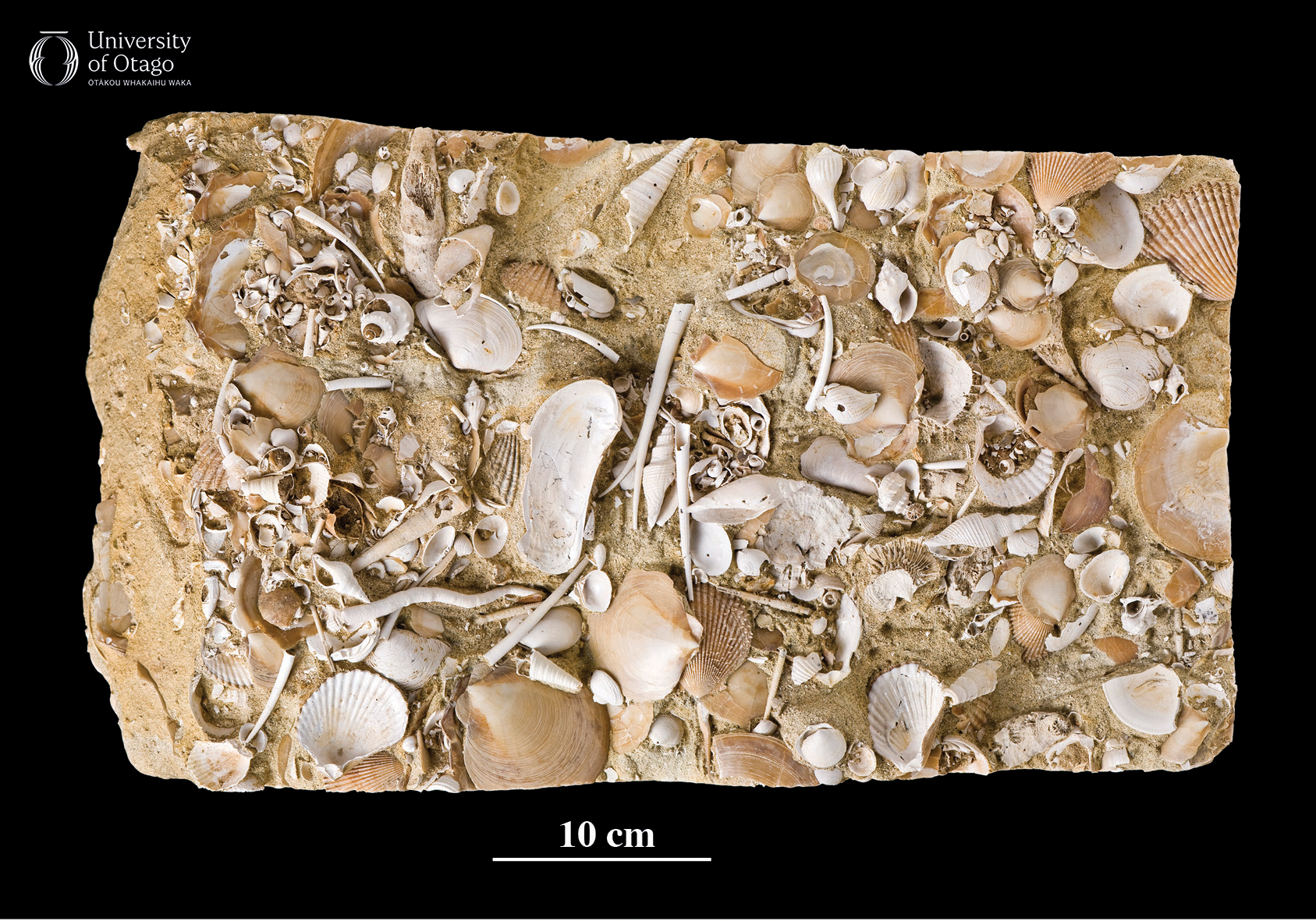41 Smooth scallop from the ancient Southern Ocean sea floor
Mollusca, Bivalvia: Lentipecten hochstetteri
On display in the foyer of the Geology Museum is a block of fossil-rich sandy limestone exhibiting an array of beautifully preserved fossils belonging to at least a dozen different phyla. This block, and a dozen more like it, were initially cut out with a chainsaw from a shell bed in a limestone quarry in South Canterbury and brought back to the Department of Geology for further study. Over many weeks, students painstakingly prepared the fossils for display as part of their “Evolution of the New Zealand Biota” GEOL 200/300 level laboratory classes. Grains of sand were removed under binocular microscopes using fine needles and paintbrushes to display the fossils.

A shark’s eye view of what the sea bed of the Southern Ocean inland from Oamaru would have looked like 26 million years ago. Lentipecten hochstetteri is the smooth-shelled scallop scattered among the other fossils. Photo: JH Robinson. |
The fossil diversity is remarkable, and the excellent preservation suggests the shells were not moved far from life position after death. The most conspicuous fossils are molluscs: dozens of bivalve and gastropod species, two species of tusk shells, smooth Dentalium and finely ribbed Fissidentalium, and one example of the nautilus-like Aturia (see: Long extinct relative of ‘The Chambered Nautilus’). Some bivalves such as the robust ark shells Cucullaea have both valves preserved, while examples of the file clam Lima still display traces of their original colouration.
Perhaps one of the most iconic fossils in the section of ancient sea floor is the smooth scallop Lentipecten hochstetteri. Lentipecten is a palm-sized scallop shell that is a common sight in limestones and greensands from North Otago and South Canterbury. In addition to its two smooth shells, Lentipecten hochtetteri is also identified from its auricles, which are smooth along the hinge end in the left valve, and mostly smooth but sometimes slightly ridged for the right valve. These are scallops were clearly an important part of the benthic community on the ancient continental shelf.
Other fossils found alongside Lentipecten hochtetteri in these ancient shell beds include bones and teeth of vertebrates, like the upper and lower jaw of a billfish (see: Game fish have ancient history in South Pacific). Microscopic foraminifera that help to date the rock as 26 to 23 million years old are abundant. Corals, bryozoans, brachiopods, barnacles, the conspicuous elongate tapering tubes of the fan tubeworm Protula, isolated spines of sea urchins and occasional entire echinoids (heart urchins) attest to the rich fossil ecosystem preserved here.
These fossils are from the Otekaike Limestone which accumulated in shallow shelf waters some distance off the eastern coast of Zealandia when much of the land area of what is now New Zealand was submerged. The limestone was deposited in fairly quiet conditions at depths of between 50 to 100 m. After death, most shells and skeletons were broken apart by scavengers and current activity to form billions of grains of limey sand. Over time the sediments were buried by younger rocks and gradually consolidated into limestone, sometimes well-cemented, sometimes hardly cemented at all (as occurred at the source of this block) allowing the fossils to be carefully extracted.
Over the past 5 million years, uplift has brought these ancient marine rocks up to the surface where modern erosion and weathering has produced the distinctive limestone outcrops and landforms characteristic of much of North Otago and South Canterbury and the UNESCO Waitaki Whitestone Global Geopark. Similar fossils are on display at the Vanished World Centre in Duntroon.
—Adapted by Daphne E Lee and Jeffrey H Robinson from text originally written by R Ewan Fordyce
| Specimen number: OU 47987 | Age: Approximately 26 million years old (late Oligocene, Duntroonian stage) |
| Locality: Hakataramea Quarry, South Canterbury | Rock Formation: Otekaike Limestone |
| Collected by: RE Fordyce | |
| Citation: Specimen not published | |
Evidence of life from a past geological age. Remains like bones, shells or wood, or an impression like a footprint, or some other evidence of life, from something that was alive more than 11,700 years ago.
A sedimentary rock composed mainly of calcium carbonate. Can be formed from the skeletal fragments of marine organisms.
A level of the classification system used to organise life that is below kingdom and above class. Organisms in one phylum generally have a very different body plan to organisms in another phylum within the same kingdom.
An inland location within southernmost Canterbury, New Zealand, where significant fossil discoveries have been made.
Technical term for each articulating shell part. For example, the shells of bivalve molluscs and brachiopods are each made up of two valves.
Also called an 'ear', auricles are the often rounded structures along the edge that forms the hinge in each valve (shell).
The dorsal edge of the shell of a bivalve mollusc where the two valves (two shells) articulate.
Relating to the bottom of a body of water.
The extended margin of a continent which is submerged under relatively shallow seas. While the width of the shelf varies between continents, most shelf seas are generally less than 100 metres deep.
Animals that have bony tissues (e.g. vertebrae, teeth) and are quadroblastic (i.e. four germ-layers: endoderm, mesoderm, ectoderm and neural crest tissue).
Coarse-grained, sandy limestone.
Part of the UNESCO Waitaki Whitestone Geopark. See: Vanished World Centre.

